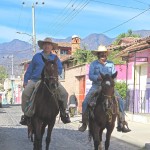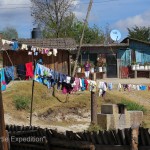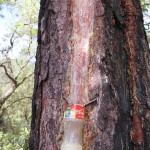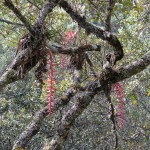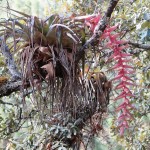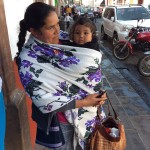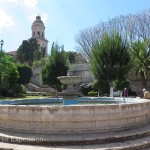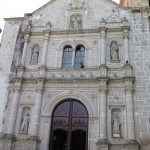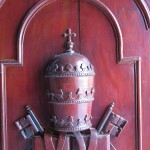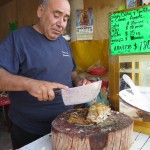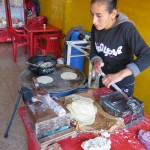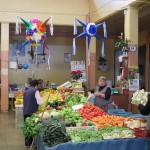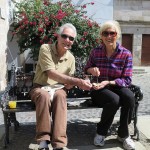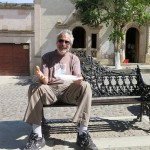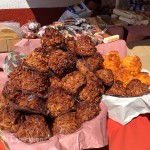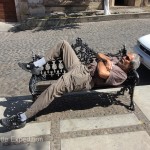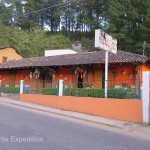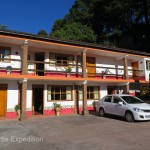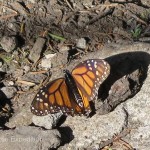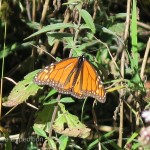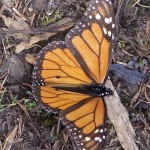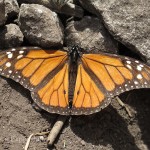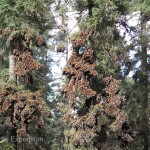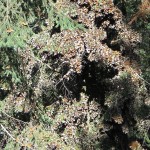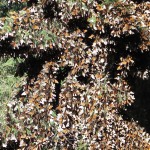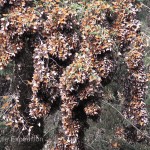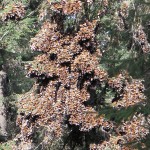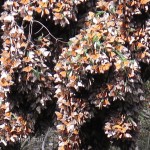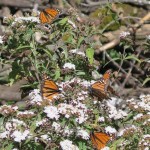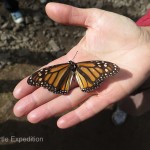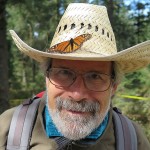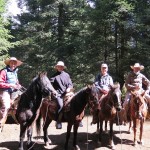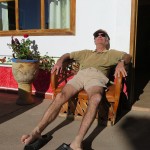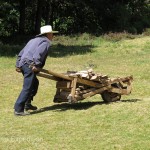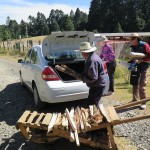Gary’s Birthday 6 – 1/2015
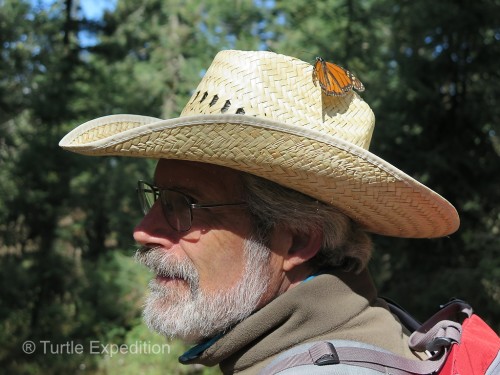 Tearing ourselves away from our beautiful guest stay in Ajijic, we headed southwest into the “dangerous” state of Michoacán, once famous for its “Sinsemilla” marijuana. Today, it is known for Lake Pátzcuaro, the Tarascan Indians, and the stopover for as many as 60 million, (even a billion) monarch butterflies who make a journey from eastern Canada to central Mexico where they spend their winter hibernation, clustered in small areas of Oyamel Fir forests at an elevation of 2,400 to 3,600 meters (7,800 to 11,800 ft.). The mountain hillsides of Oyamel forest provide an ideal microclimate for the butterflies. The Reserva de la Biosfera Mariposa Monarca (Monarch Butterfly Biosphere Reserve), a national protected area and nature preserve which covers more than 200-square-miles.
Tearing ourselves away from our beautiful guest stay in Ajijic, we headed southwest into the “dangerous” state of Michoacán, once famous for its “Sinsemilla” marijuana. Today, it is known for Lake Pátzcuaro, the Tarascan Indians, and the stopover for as many as 60 million, (even a billion) monarch butterflies who make a journey from eastern Canada to central Mexico where they spend their winter hibernation, clustered in small areas of Oyamel Fir forests at an elevation of 2,400 to 3,600 meters (7,800 to 11,800 ft.). The mountain hillsides of Oyamel forest provide an ideal microclimate for the butterflies. The Reserva de la Biosfera Mariposa Monarca (Monarch Butterfly Biosphere Reserve), a national protected area and nature preserve which covers more than 200-square-miles.
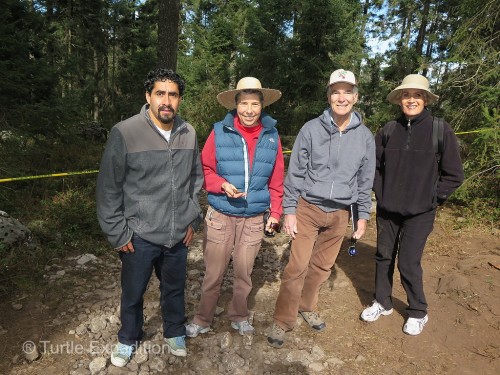
Oscar Reyes, our English speaking guide to the Monarch Butterfly Sanctuary, shared his extensive knowledge of the area.
Arriving in the mountain town of Anguangueo, we settled into the cute Plaza Don Gabino hotel and made a plan. Oscar Reyes (email: rrosco@live.com, phone: 715-127-2308), an official English speaking guide, approached us politely and asked if we needed his help in viewing the butterflies. That turned out to be a very good idea.
The next morning as we climbed into the mountains the smell of pitch dripping from pine trees into containers filled the air. Pine resins have been used for thousands of years for waterproofing, varnishes, adhesives, art, incense, medicines, turpentine, rosin for bowed string instruments, gymnasts, baseball pitchers, oil-paint thinner, furniture wax, lamp oil, soap and tar. Many trees were decorated with delicate bromeliads.
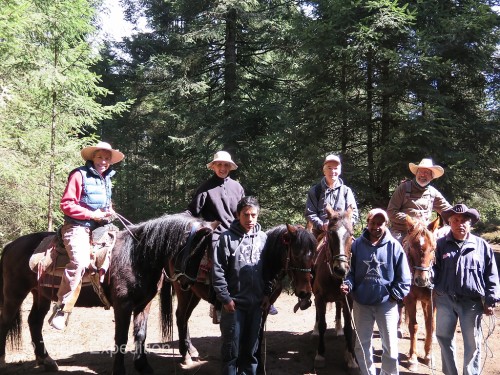 Arriving at the Reserva de la Biosfera Mariposa Monarca and maybe feeling lazy or blaming the altitude, we took the opportunity to ride horses up to the reserve. It was a dusty trail and well worth the small charge.
Arriving at the Reserva de la Biosfera Mariposa Monarca and maybe feeling lazy or blaming the altitude, we took the opportunity to ride horses up to the reserve. It was a dusty trail and well worth the small charge.
The annual migration of North America’s monarch butterfly is a unique and amazing phenomenon, one of the most spectacular natural events in the world. What makes it even more incredible is that no individual butterfly completes the entire round trip. Female monarchs lay eggs for the next generation during their migration and at least five generations may be involved in the annual cycle.
The monarch is the only butterfly known to make a two-way migration as birds do. Unlike other butterflies that can overwinter as larvae, pupae, or even as adults in some species, monarchs cannot survive the cold winters of northern climates. Sensing environmental cues, the monarchs know when it is time to travel south for the winter. Using a combination of air currents and thermals to travel long distances, some fly as far as 3,000 miles to reach their winter home! We realized, the butterfly that landed on my hat was perhaps the great-great-great-grandchild of a monarch that wintered here the previous year. Clearly one of nature’s unexplainable miracles.
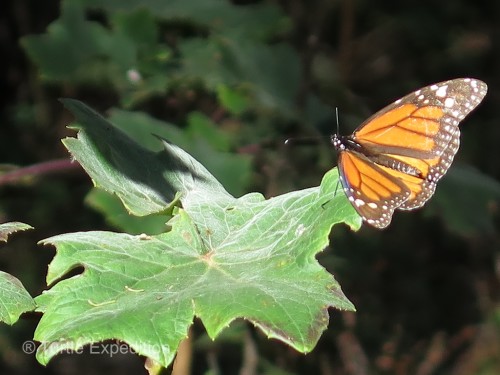 Staying on secondary roads gave us a chance to see a slice of rural Mexico. Still no sign of bandits or drug cartel gangs. It was noon when we came to the small town of Charo, founded in 1455. With its beautiful church and plaza, it was too inviting to pass up. While the local butcher chopped up some warm carnitas, the girl next door made fresh corn tortillas and we found some ripe tomatoes and avocados in the open market. Lunch was ready.
Staying on secondary roads gave us a chance to see a slice of rural Mexico. Still no sign of bandits or drug cartel gangs. It was noon when we came to the small town of Charo, founded in 1455. With its beautiful church and plaza, it was too inviting to pass up. While the local butcher chopped up some warm carnitas, the girl next door made fresh corn tortillas and we found some ripe tomatoes and avocados in the open market. Lunch was ready.
On the return trip to Guadalajara we had a couple more favorite spots to visit. Hey, it was still my birthday and I was going to stretch it out as long as possible. Winding our way northeast again we headed for the colonial town of Pátzcuaro and nearby of Santa Clara del Cobre, home of Mexico’s famous coppersmiths.
- Staying on secondary roads gave us a chance to see a slice of rural Mexico. Still no sign of bandits or drug cartel gangs.
- Pine resins have been used for thousands of years for waterproofing, varnishes, adhesives, art, incense, medicines, turpentine, rosins for bowed string instruments, gymnasts, baseball pitchers, oil-paint thinner, furniture wax, lamp oil, soap and tar.
- We stopped often to photograph some of the interesting bromeliads hanging from the trees.
- A wonderful image of rural Mexico where women still carry their children in “rebozos”.
- A sign of the times. In this very typical local mini store or “abarrotes”, the sign says, “Take care of your health. Eat only fresh chicken without preservatives.”
- The pretty plaza in the town of Charo, Michoacán made an ideal lunch stop.
- The old church of San Miguel Arcángel in Charo was preparing for a special celebration of a girl’s first communion.
- Warm “carnitas” just out of the kettle and chopped to our order.
- Fresh hot tortillas handmade from freshly ground corn, not “maseca” (corn flour). Ready for lunch?
- We found ripe avocados and tomatoes to add to our lunch on the road in the open market.
- Cousin Carol slices up a ripe avocado to add to our tacos for lunch in the plaza.
- Fresh carnitas in fresh tortillas with slices of avocado and tomato and maybe a slice of hot jalapeño chili. What’s for dessert?
- Toasted balls of shredded coconut dipped in honey.
- Never miss a chance for a siesta, a wonderful Mexican tradition.
- We found the Plaza Don Gabino hotel online in the town of Angangueo, Michoacán near the Reserva de la Biosfera Mariposa Monarca.
- The monarch is the only butterfly known to make a two-way migration as birds do.
- Millions of monarchs rested in the Oyamel Fir forests at an elevation of 2,400 to 3,600 meters, (7,800 to 11,800 ft.).
- The butterflies that landed on us were perhaps the great-great-great-grandchildren of a monarch that wintered here the previous year. Clearly, one of nature’s unexplainable miracles.
- Being around 10,000 ft. above sea level, we opted for the horses to reach the reserve.
- Doug takes advantage of the Mexican siesta.
- The Plaza Don Gabriel Hotel wanted $5 for six pieces of firewood. The gentleman we met at the reserve brought us a cartload for $5 and even threw in some pitch wood for fire starters. Check out the cool handcart with a wooden wheel.
- The end of another wonderful day celebrating my birthday. Why do we wait a whole year to do things like this?



